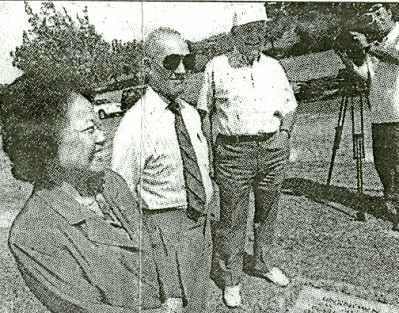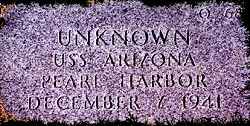|

by Walter Wright
Advertiser Staff Writer |
Markers:
Arizona Shipmates Identified |

U.S. Rep. Patsy Mink, cemetary director
Gene Castagnetti and Pearl Harbor historian Ray Emory at Punchbowl.

New Marker.
Mouse-over for marker with NO name of ship, branch of service,
mention of WWII, date of death. |
Verbatim from article November 5, 2001
Seventy new Pearl Harbor headstones were unveiled at
Punchbowl yesterday, letting the world know that the unknown
remains are those of 124 shipmates from the USS Arizona.
U.S. Rep. Patsy Mink (D-Hawaii), who wrote the legislation
ordering the new inscriptions on the headstones, said the
military has known since the infamous Japanese attack where the
remains came from, if not whose they were.
But when the bones were brought to the National Memorial
Cemetary of the Pacific at Punchbowl when it opened in 1949,
they were put into graves marked only "Unknown, Dec. 7, 1941."
|
|
Many survivors of the attack on
Pearl Harbor have felt for years that the label was inadequate for
sailors who gave their lives for their country, despite that the names
of all 2,341 people killed in the attack are on identified graves or
carved into the Carrara marble of the Courts of the Missing at the
Honolulu Memorial at the cemetery.
And some officials, including cemetery director Gene Castagnetti,
had worried that putting additional historical information on the
headstones would set bad precedent and dim the dignity associated with
the simple "unknown" designation.
But advocates of the change would not be stilled.
Mink credited Ray Emory, Pearl Harbor Survivors Association chief
historian, and Lorraine Marks-Haislip, historian for the USS Arizona
Reunion Association, with doing the research and fighting for years to
bring about the change.
But much of the credit, it appears, should also go to a U.S. Army
officer identified yesterday only as Colonel Stewart.
It was he, Mink said yesterday, who three years ago abruptly sent
Mink "this flatout letter saying, 'This is the last letter we are going
to reply to you, lady. We are tired of your correspondence on this
issue.'"
Mink said she was so irritated by the letter that she wove it into
a speech she gave at the 1999 ceremony at the Arizona Memorial. "I said,
'I'm not going to take it any more and they are going to hear from me by
legislative edict,'" she recalled.
"It was the last straw. If he had been a little more patient with
me, or given me more runaround, I would probably still be writing
letters."
But the colonel underestimated the fury of a congresswoman scorned,
and Mink "wrote a little paragraph in the big military authorization
bill" last year.
The words "USS Arizona" were irresistible, she said.
"I didn't have to do much lobbying. It's probably the fastest that
anything ever got through Congress: I put it in in March and it became
law in September." And Mink isn't finished.
Emory says there are other remains in the same situation, nearly
400 of them from sailors aboard the USS Oklahoma, and from other ships
or posts in the harbor on that bloody day.
Mink said that with the precedent set by the Arizona case, she
hopes the Army and the Veterans Administration will see fit on their own
initiative to add to the other headstones the known ships from which
unknown remains in other Punchbowl plots have come.
If the Army doesn't act, she said, she has assurances that Congress
will again. |
Copyright © 2002-2018 Lorraine Marks-Haislip
|